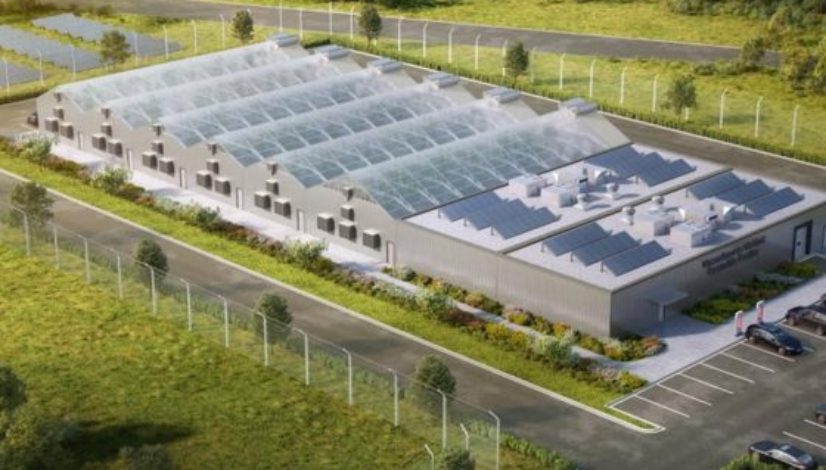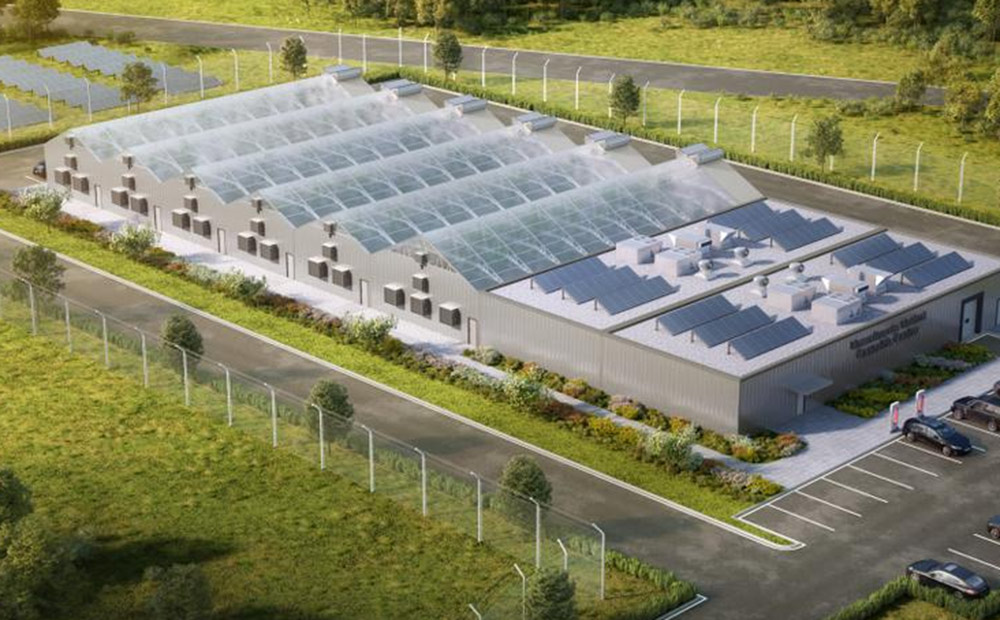Trading veggies for herb: Produce grower planting cannabis in million-square-foot greenhouse

Published: Jul 27, 2017, 7:42 am • Updated: Jul 27, 2017, 2:36 pm
By Alicia Wallace, The Cannabist Staff
In a vast greenhouse that operates about 30 miles outside Vancouver, British Columbia, hundreds of thousands of plants yield an abundance of colorful tomatoes.
Come this time next year, the massive 1.1 million-square-foot facility will be outfitted for a different kind of harvest: marijuana.
Village Farms International Inc., an established provider of greenhouse-grown produce, is jumping into the cannabis business just as Canada closes in on national marijuana legalization.
The company will convert that 1.1 million-square-foot greenhouse — about the size of 19 football fields — to cannabis and earmark another 3.7 million square feet of greenhouse space for potential cannabis cultivation as part of a newly established joint venture with Emerald Health Therapeutics, a licensed Canadian medical cannabis producer.
The partnership represents a “transformational opportunity” for the company that distributes hydroponically grown tomatoes, cucumbers, peppers and eggplants across much of North America, said Michael A. DeGiglio, Village Farms’ chief executive officer.
Village Farms can apply nearly three decades of greenhouse expertise and utilize its massive facilities to supply a good swath of a brand-new market, DeGiglio told The Cannabist. Canada legalized medical marijuana in 2001 and the country’s government is working toward legalizing the recreational use of cannabis by July 2018.
Related stories
- Can nutrients make cannabis taste bad? Learn more about using fertilizers and flushing when growing marijuana
- EPA fines Colorado hydroponics shop for sale of unlabeled pesticides
- How many lights do you need in a greenhouse? Our expert weighs in
- How to grow weed in any climate: six top tips
- How to get rid of spider mites on marijuana plants: Keep it clean
The move into cannabis is all about business, he added. As a public company, Village Farms has a fiduciary responsibility to do right by its shareholders.
“It’s not about a moral issue,” DeGiglio said. “We just had to take a hard look. Initially, when it was only medicinal, we didn’t really want to get into that.”
By the joint venture’s estimates, the initial greenhouse conversion could yield at least 75,000 kilograms (about 165,350 pounds) of product annually. The output could be quite lucrative, officials said, noting projections that the cannabis could generate revenue 10 to 15 times that of produce.
The lessons learned in the vegetable industry will help the company make the “innovative move to grow,” DeGiglio said.
“It’s farming, and it’s tough — it’s hard, things go wrong,” he said. “We’ve learned in three decades from the school of hard knocks, and we think that has some value.”
Village Farms’ annual sales have slowly, but surely, increased in recent years, settling in at C$193 million ($155 million U.S.), according to the company’s SEDAR filings. Tomato sales have been a little tepid, putting some additional squeeze on the margins.
Considering the various undulations of commodity crops, Village Farms executives told investors they were “actively exploring whether to produce certain higher-margin alternative crops,” following the annual earnings report release in March 2017.
The company has spent months analyzing the market, regulatory processes and players; communicating with Health Canada; and weighing whether to go it alone or alongside a partner. The goal, DeGiglio said, was to become the lowest-cost greenhouse producer of cannabis in Canada without sacrificing the quality of the end-product.
Investing millions to add a vault, more security
Village Farms landed on a partnership with Emerald Health Therapeutics, a company with the stated goal of becoming the “world’s biggest marijuana producer,” but little large-scale growing experience.
“It became very obvious to us that, rather than reinventing the wheel, that there were already experts,” Dr. Avtar Dhillon, Emerald Health’s chairman, said of the partnership with Village Farms.
Emerald ponied up more than C$20 million ($16 million) in cash to help fund the conversion of the first greenhouse, the companies announced in June. Each firm received a 50 percent stake in the joint venture.
When Canada’s cannabis market expands to recreational, the demand could be as much as 600,000 kilograms annually, he said. If Emerald Health exercises the options on the other two greenhouses, the production capacity could rocket to 300,000 kilograms.
Together, the companies have a conservative target of production costs under C$1 per gram. That’s compared to the C$2.25 per-gram production costs cited in the Canada Parliamentary Budget Office’s fiscal considerations.
With Canada-wide adult-use cannabis sales starting as early as July 1, 2018, the short-term is key for the joint venture. The companies hope to have at least half of the 25-acre, 1.1 million-square-foot facility up and running by the first quarter of next year.
“There is a certain race to be able to supply to that demand,” Dhillon said.
There’s also certain benefit for being one of the first large-scale cultivators to market as the global cannabis landscape changes and more countries implement sales and import-export procedures, he said.
“Part of our equation here is to be one of the biggest extractors in the world,” he said.
Pro Growing column
- Learn how biocontrols work to beat the bad bugs that wreck cannabis crops
- Irrigation systems: Why commercial cannabis growers should go with the flow
- Does my commercial cultivation qualify as organic? Can I be certified?
- Commercial cannabis cultivation tips from an organic farmer with a horticulture degree
Following this November’s tomato harvest, work will get underway to outfit the Village Farms facility for its new crop. Required additions include blackout screens, growing systems, fencing, security cameras and a vault among a laundry list of other quality-assurance and security measures.
In all, the cost of retrofitting the facility is an estimated C$35 million endeavor ($28 million), Dhillon said.
Village Farms’ venture into cannabis only goes so far, DeGiglio said. By no means is the company scrapping its traditional business, and the majority of the company’s 10.5 million square feet of greenhouse capacity will remain dedicated to veggie production.
That core business, however, is “changing at the speed of light,” and Village Farms is looking at potential acquisitions in addition to forging ahead on the cannabis venture, he said. He hasn’t seen a similarly positioned competitor, but he wants to prepare the company for stiff competition.
“It usually takes somebody to lead the effort — and then come the ‘me toos,’” he said.
Going big in Massachusetts
Stateside, one Denver-based company is also eyeing large-scale greenhouse cannabis cultivation.
AmeriCann has initiated preliminary site work on a nearly 1 million-square-foot operation in Massachusetts, where voters approved a recreational marijuana measure in November 2016.
A rewrite of the proposed marijuana laws is currently before Gov. Charlie Baker, but as the state moves towards enacting the will of the voters, it clearly lacks the cultivation infrastructure to meet demand for medical and adult-use cannabis, said Tim Keogh, AmeriCann CEO.
With a population of 6.8 million, the state is projected to realize a medical marijuana market of 150,000 patients, he said. But at present there is about 200,000 square feet of cultivation infrastructure.
By comparison, he estimates that Colorado had a couple of million square feet of cultivation operations to supply a smaller patient population.
To meet future demand, the nascent Massachusetts marijuana industry sought expertise from Colorado growers, he said. As a result the state has ended up with lots of operators who know how to find, outfit and run 10,000- to 20,000-square-foot indoor cultivation centers, the manner in which much of Colorado’s marijuana is grown.
“The result we have now is a real lack of infrastructure,” Keogh said. He thinks large-scale grow facilities are lacking across the country.
“Our vision is really to become the leading provider of state-of-the-art sustainable infrastructure to really meet the needs of markets as they come online,” he said.
 AmeriCann has initiated preliminary site work on a nearly 1-million-square-foot cannabis greenhouse in Massachusetts. (Rendering courtesy of AmeriCann)
AmeriCann has initiated preliminary site work on a nearly 1-million-square-foot cannabis greenhouse in Massachusetts. (Rendering courtesy of AmeriCann)
The greenhouse industry recognizes cannabis as a cash crop, but not all players have welcomed the newcomer with open arms, according to Agrilyst, a greenhouse data and analytics company.
“Though many growers agree that cannabis is the most profitable crop, most do not plan to grow it in the next five years,” Agrilyst analysts wrote in the company’s 2016 State of Indoor Farming report.
Indoor cannabis is 9,000 times more productive than outdoor commodity farming and generated crops at about $112 per square foot, or about $4.8 million per acre, Agrilyst found. Cannabis could fetch $378.21 per pound as compared to $12.63 per pound of microgreens and herbs.
Strict licensing and an uncertain regulatory future leaves growers hemming and hawing as to whether they’d throw cannabis into a rotation. The ones who do, though, might not do so on a large scale, said Adam Koh, cannabis expert and editorial director for Cannabis Benchmarks, a provider of price assessments for the cannabis industry and division of Stamford, Conn.-based New Leaf Data Services LLC.
“The type of capital you would need to finance an operation of that size, raising it here in the U.S., would present a pretty steep hill to climb,” he said. “It’s a pretty big ask.”
And that “big ask” gets all the more complicated when considering that federal action — such as a rescheduling — could flip regulations and the market on its head, he said.
“To put all one’s eggs and money into a single model, when the ground can still shift under your feet in various directions, is always a risky proposition,” he said.
The changing composition of cannabis product sales is also shifting the equation for growers, Koh said. Consumers are leaning more and more toward extract-heavy products such as edibles and concentrates, making production a volume game.
“It’s a high-risk, potentially high-reward situation,” he said.
Topics: americann, Canada, commercial cultivation, greenhouses, growing marijuana, indoors, Massachusetts, professional growing  Alicia Wallace
Alicia Wallace
Alicia Wallace joined The Cannabist in July 2016, covering national marijuana policy and business. In her 14 years as a business news reporter, her coverage has spanned topics such as the economy, natural foods, airlines, biotech, retail,…




